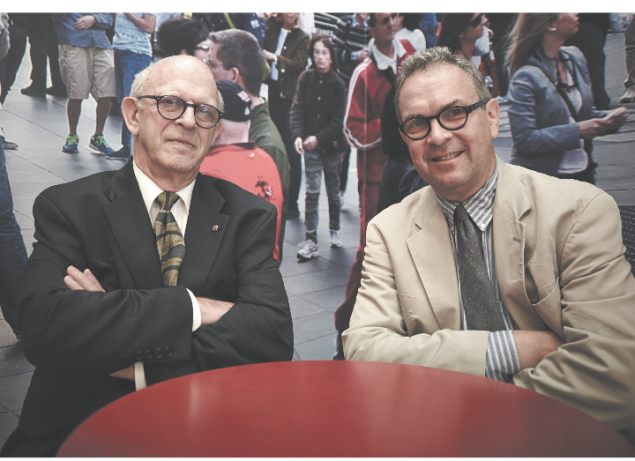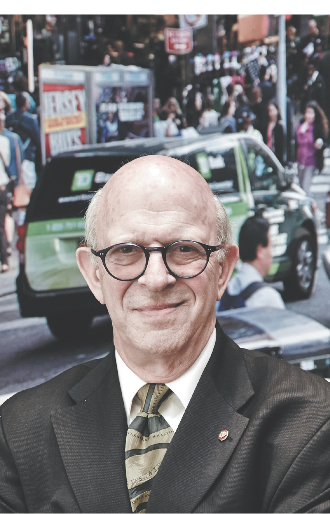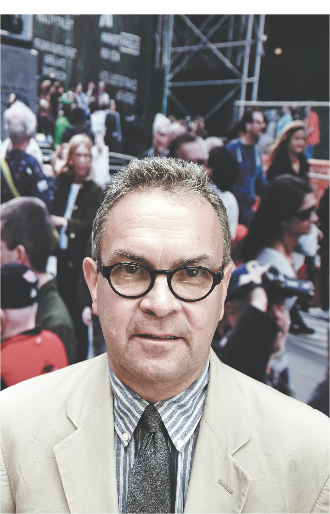
Near the end of Commercial Observer’s visit to the Center for Architecture in the South Village, Lance Jay Brown of the American Institute of Architects’ New York Chapter excused himself for a moment to approach a group of students. The teenagers were in front of a picture of the Occupy Wall Street crowds of 2011 at Zuccotti Park discussing how to create public spaces as part of one of the museum’s hundreds of annual programs for local students and residents. Far from interjecting to discuss his local, national or international urban design experience, Mr. Brown grinned and tiptoed toward the powwow to snap a picture of the engaged youngsters with his cell phone without disturbing the conversation. Then the 71-year-old president of the influential founding chapter of AIA shook hands with one of the group’s leaders, and, a few moments later, pedaled away from the center on a bicycle.
Mr. Brown, FAIA, president of AIANY and Executive Director Rick Bell, FAIA, are steering the 157-year-old, 5,000-member organization of architects, collaborating professionals and students into the future as the city continues to grow in height and population. The two decorated architects are also leading the fight to ensure that future vision includes places where people interact with fewer rules and barriers and more services and infrastructure.
Messrs. Brown and Bell opened the current exhibition at the center, “Open to the Public: Civic Space Now,” last month with the hope of advancing the fraught debate over what constitutes and threatens public areas. While they speak admiringly of some city programs and new developments, they’re pushing for changes to zoning, design and—yes—bathroom access in ways that could provoke opposition. But these visionaries would be more likely to invite their adversaries to a panel than to make any true enemies at the advocacy and trade organization that’s doubled its membership since the center launched in 2003.
“It almost underscores the notion of the importance of gathering places, cultural institutions and the fact that we seek to engage people,” Mr. Brown said of the organization’s growth since opening the Village location. “We’re at a moment of extreme vitality.”
He’s navigated through many moments like this before. Mr. Brown has authored or co-authored five books and completed more than 70 projects at his eponymous firm; he also helped lead urban planning collaborations in Detroit, overseas design workshops in Tbilisi, Georgia, and research studies of Midtown and upper Manhattan, as well as on the Brooklyn waterfront.

Mr. Bell, 62, co-edited an anthology with Mr. Brown and two colleagues called Beyond Zuccotti Park: Freedom of Assembly and the Occupation of Public Space last year. The bikeshare enthusiast spent 15 years designing educational facilities and libraries at Warner Burns Toan Lunde, followed by an eight-year stint as the chief architect and assistant commissioner for architecture and engineering at the city’s public works agency, the Department of Design and Construction.
“We both as architects have had fairly non-traditional careers,” said Mr. Bell. “It gives us perspective on how architecture impacts people’s daily lives.”
The center’s current exhibit runs through Sept. 6 and features 13 open, public areas in the city, as well as one each from Houston, Los Angeles and Chicago. The Zuccotti Park picture places the Brookfield Properties-owned park in the context of Tahrir Square and other Arab Spring locales. Other displays examine Times Square, the new Four Freedoms Park on Roosevelt Island and the 250 miles of bike lanes the city has installed since 2006. With a mindful attention to controversies surrounding public areas like Brooklyn Bridge Park and facts like the anticipated 350,000 anticipated annual visitors to the High Line having turned into more than 4 million, the exhibit draws attention to the political and cultural significance of common, open areas in the city.
“We must never take public space for granted,” Mr. Brown wrote in a preface to the exhibit. “When it is usurped for purposes that thwart the possibility of gathering, it is lost. When it is claimed by the people, for the people, of the people, it is found.”
The two AIANY leaders also maintain a constant presence in all zoning matters. And, beyond cheering proposed indoor public space next to Grand Central Terminal at SL Green Realty Corp.’s 1 Vanderbilt and the under-construction outdoor plazas at the Hudson Park and Boulevard at Hudson Yards, they’re hoping to advance a comprehensive conversation on the city’s 1961 Zoning Resolution. The organization’s 30-plank report from May 2013, “A Platform for the Future of the City,” calls for increased capital spending on infrastructure, full build-outs of areas with unused development rights and collaborative creation of a new long-term strategic plan for zoning changes to accommodate the city’s continuing growth.
“‘Unlocking’ is a great word—that was the goal of what we proposed,” Mr. Bell said, referring to the potential the plan could tap. But, he adds, they understand that positions like reducing parking requirements for some new developments or creating more bike lanes around the city might ruffle feathers. “There are going to be some political fights ahead that are going to lead to treatment of the Zoning Resolution as if it’s Talmudic quality.”
And public spaces, especially privately-owned ones where developers can build higher in exchange for offering new pubic areas, represent one issue in which zoning rules have amassed a vast, but mixed, record. Developers created 80 acres of indoor and outdoor areas for the public while building 16 million square feet of additional private space at their properties under the program, but a significant portion of the privately-owned public spaces suffer from limitations, according to research by the Department of City Planning, the Municipal Art Society and Harvard University professor Jerold Kayden. While the city ramped up enforcement against some bad actors who were restricting public access to the spaces or allowing private uses to encroach on the required amount of public space after the researchers’ 2000 study, Mr. Kayden says findings that 41 percent of the 525 spaces have little value to the public and around 50 percent of them are out of compliance remain mostly the same today. That’s why Messrs. Brown and Bell’s campaign to draw attention to public spaces matters so much, said Mr. Kayden.
“Unfortunately, public space needs advocates to keep it public,” said Mr. Kayden, who is also the founder of Advocates for Privately Owned Public Spaces. “People like Rick and Lance perform an incredibly valuable role in pushing it into people’s faces.”

The professor spoke at a panel discussion hosted by the center last week entitled “Who Pays for Public Spaces?” that focused on the complexities of funding streams for the spaces. The city has created 65 new pedestrian plazas under the Department of Transportation’s NYC Plaza Program, said the division’s director, Emily Weidenhof. She and her staff turn medians, sidewalks and other common areas into lounge and rest spots using both city and federal money, as well as small amounts of state and private support.
“It’s just like a road,” said Ms. Weidenhof. “It needs maintenance, and it needs money to be continually invested.”
Despite the finite nature of government budgets, Messrs. Brown and Bell insist that government spending on public spaces represents a worthwhile investment, especially in a crowded yet expanding global city.
“One thing that characterizes life in New York City is smaller apartments and longer work days,” Mr. Brown said. “The ability to be outside of an often-shared apartment—it’s certainly a benefit.”
Restrooms exemplify yet another area in need of additional resources, according to the two AIANY leaders. The group’s platform calls for more public bathrooms for users of the city’s 12,750 miles of sidewalks. The center embodies its contention that public places ought to fill that basic human need, Mr. Bell said, noting a previous event on restrooms at the center.
“The conference on public toilet design also came back to that great lack,” he said. “Our facility is publicly-supported; our bathrooms are completely open to the public and people come in and use them.”
The two have clearly embraced a towering profile on scale with the skyscrapers and visionary designs that dominate the city’s landscape. But the professional collaboration, political advocacy, scholarly research and public engagement fit their particular trade, said Mr. Brown.
“Architecture is an unbelievably subtle investment,” he said. “What goes into forming buildings has so many facets that makes it so exciting.”


